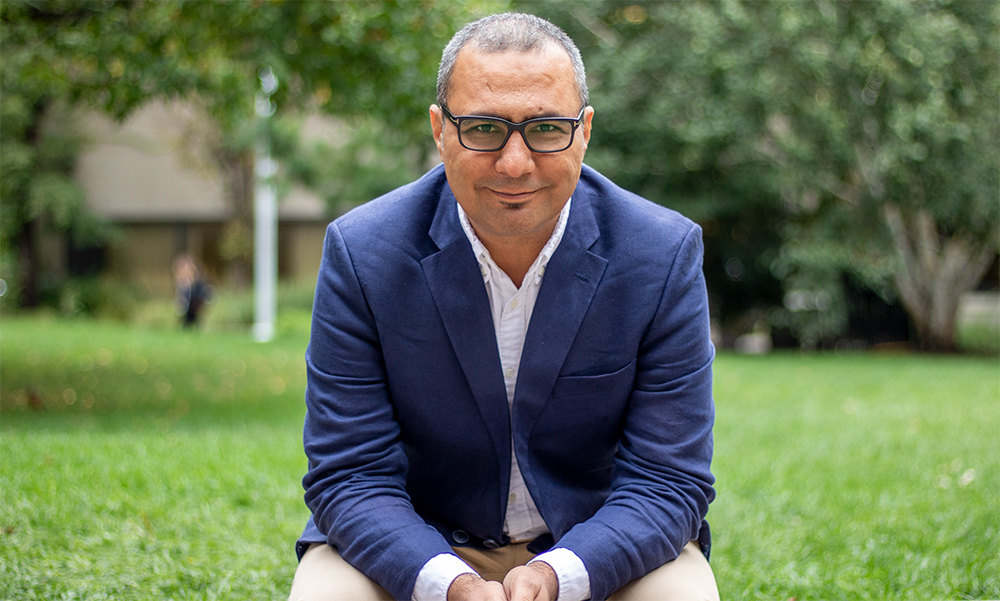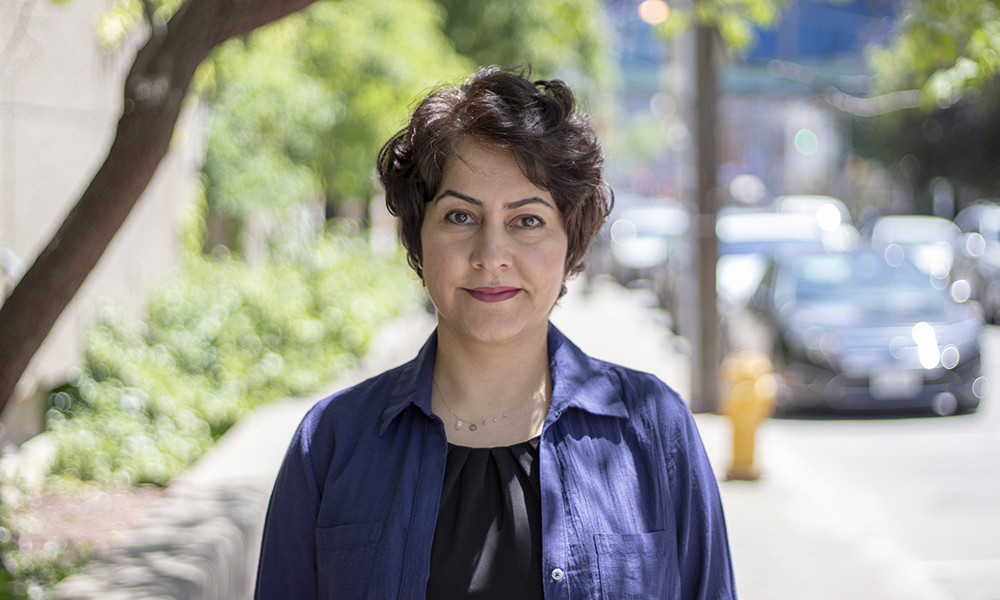Ryerson joins centre of excellence for greener, smarter freight transportation
The Greater Toronto and Hamilton Area (GTHA) has seen tremendous growth in goods deliveries fueled by online commerce and just-in-time delivery. The volume of deliveries has surged during COVID-19–online shopping more than doubled in the first three months of the pandemic according to Statistics Canada (external link) –and solutions are needed more than ever to mitigate congestion, air pollution and greenhouse gas emissions caused by the increase of diesel trucks on our streets.
This month, a team of Ryerson researchers joined the Smart Freight Centre (SFC) (external link) , a centre for excellence in goods movement that is bringing together a network of academic, government and private institutes in the GTHA. The Ryerson research team will receive funding to study, test and implement innovations to tackle the goods movement challenge in the GTHA.
Solving “last mile” goods delivery with drones and robots
The “last mile” of the goods delivery chain moves goods from a transportation hub or fulfilment centre to the final delivery destination, such as a personal residence or office. It is this stage of the delivery process that clogs neighbourhood streets and contributes to local air pollution and road safety hazards. According to researcher and Canada Research Chair in Disruptive Transportation Technologies and Services Bilal Farooq, drones and robots could move packages around much more safely and efficiently on sidewalks and above our buildings.

Researcher and Canada Research Chair in Disruptive Transportation Technologies and Services Bilal Farooq is the SFC lead for Ryerson.
“With the increase in the use of on-demand goods delivery, we are adding more trips on an already congested road network in the GTHA. There is a strong need for new delivery modes that can avoid further deteriorating the travel times for the commuters. Technologies like sidewalk robots and flying drones have great potential in this context,” explains Farooq, who directs the Ryerson LiTrans Lab (external link) , where his team simulates automated vehicles, both passenger and freight.
In a recent project (external link) , Farooq and his students developed a simulation framework to design and analyze solutions for last-mile food delivery in Mississauga, using automated robots and drones. A hybrid robot-drone system with hub-and-spoke design was able to not only avoid adding extra trips on the road network, but could deliver faster delivery times for current food-delivery apps.
Farooq and his research team will work with the SFC to build on this work. They will collaborate with academics from other universities, the public sector and industry partners to develop real-time routing solutions for freight on urban roads to consider a range of competing objectives, such as congestion level, cost and greenhouse gas emissions.
Smarter freight with better data
The movement of goods can be improved significantly by consolidating deliveries so there are fewer half-empty trucks driving around, optimizing dynamic routing in real time, and matching supply and demand. But real-time data is required to do this. For datasets to be reliable and effective, a number of data sources need to be fused and analyzed, and issues of data privacy and cybersecurity need to be addressed.
Ryerson has developed internationally recognized expertise in travel data management, fusion of data, and analytics, as well as in the emerging privacy and cybersecurity issues related to mobility. Assistant Professor Atefeh Mashatan at the Ted Rogers School of Management and director of the Cybersecurity Research Lab (CRL) and Farooq will collaborate with other participating universities, regional companies, municipalities and different levels of government to develop research on freight data management, fusion, on-demand analytics as a service, owner-driven privacy management and future-proofed cybersecurity, using their expertise in Internet-of-Things (IoT) security and privacy as well as blockchain technology.
“These datasets may contain sensitive information on companies as well as individuals giving rise to information security and privacy concerns. Owner-driven privacy management enabled by blockchain technology can address such concerns by design. A digital wallet for the freight industry that uses self-sovereign identities (SSIs) can enable secure workflows and reliable transactions, as well as support the required level of anonymity. It will also result in rich information that can later be used to develop diagnostic, predictive, and prescriptive analytics to improve the planning and operations of multimodal freight management,” explains Mashatan.
Mashatan and Farooq have extensive experience in the use of blockchain technology and are currently advising businesses on the adoption of this technology under the National Research Council’s Industrial Research Assistance Program. SFC is expected to provide important outreach to the companies working in the freight transportation domain.
Automated freight, road design and safety
Automated and connected freight vehicles offer potential cost savings. Practices such as platooning trucks can optimize operations but require serious actions related to safety, geometric road design, and operation. Automation, design and safety can also optimize operations for docking and drayage (moving goods a short distance via ground freight).
Researcher Said Easa, director of Ryerson’s Road Safety Research Laboratory (RSR Lab) is an internationally-recognized expert in the area and will collaborate with researchers and other partners in the SFC to develop safe and operationalized solutions.

Researcher Said Easa is the director of Ryerson’s Road Safety Research Laboratory.
In a recent project, Easa and his team developed a method for path planning and control for the overtaking of autonomous vehicles on two-lane highways, as well as for automated parking of passenger cars and single-unit/articulated trucks in restricted spaces. They can also optimize route planning for automated trucks and analyze “Internet of Vehicles” to improve fuel efficiency.
Easa’s Road Safety Research Lab has also used a driving simulator to analyze the driver’s mental workload, impact of geometric road design on safety, and effect of increased lighting at nighttime on the performance of older drivers. The simulator, which includes vehicle dynamics modules and eye-tracking equipment, is a valuable tool for some aspects of freight research.
“One of my freight initiatives is the modeling of automated drayage and docking of trucks which are frequently noted as highly desirable by the trucking industry, with a focus on the movement of loaded and empty containers by commercial vehicles between customers, internal terminals, and equipment yards,” says Easa. “I am really so excited to use my expertise in planning, design, operation, and management to develop innovative solutions in the area of automated freight transportation,” he added.
Reliability for rail freight
Reliability and maintenance are becoming increasingly critical issues in freight. It is estimated that rail companies in North America will have to spend more than USD 2 billion in rail asset maintenance. Researcher and Canada Research Chair in Physical Asset Management Sharareh Taghipour who is also the director of the Reliability, Risk and Maintenance Research Laboratory (RRMR Lab), will develop the research in reliability and maintenance in multimodal freight operations, including exploring the Internet of Things (IoT), blockchain and cloud technologies for asset management.

Researcher and Canada Research Chair in Physical Asset Management Sharareh Taghipour is the director of the Reliability, Risk and Maintenance Research Laboratory.
“With the adoption of smart communication technologies and the use of big data analytics, real- time or near real-time decision-making can be achieved for rail freight management, which includes asset utilization, deployment, and maintenance,” explains Tahgipour.
Ryerson urban innovation in action
Research and innovation require optimal space to test, simulate and study. That's why, with the support of Sri Krishnan, associate dean of research and external partnerships, many of the research projects with the Smart Freight Centre will take place in Ryerson's Centre for Urban Innovation.
The Centre of Urban Innovation on the Ryerson campus is an active hub for research labs and student learning zones, working on urban water management and conservation to transportation planning and more.